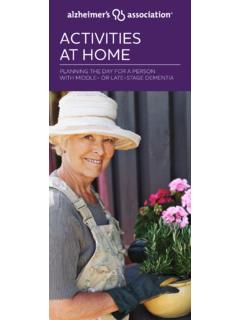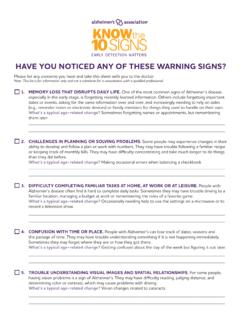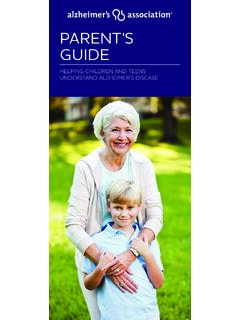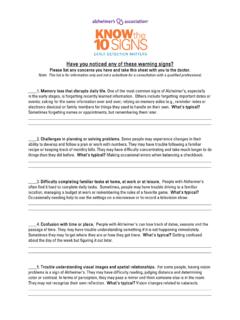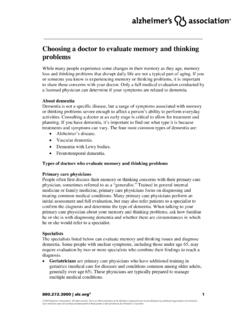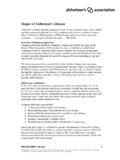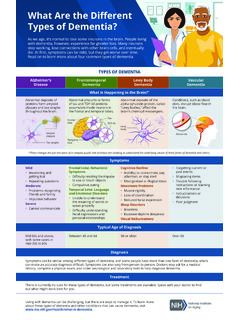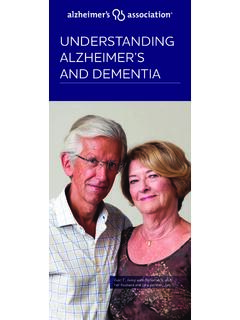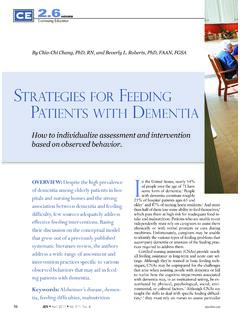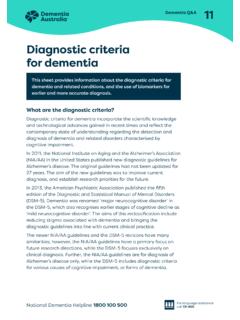Transcription of Evidence on Interventions to Improve Quality of Care for ...
1 Evidence on Interventions to Improve Quality of Care for Residents with dementia in Nursing and Assisted Living Facilities Jane Tilly, and Peter Reed, The Alzheimer's Association Copyright 2004 by the Alzheimer's Association. All rights reserved. Abstract Background: People with dementia in nursing homes and assisted living facilities are vulnerable to negative health and Quality of life outcomes, which could be averted through the provision of appropriate care. Assuring high Quality care for these residents should be informed by a thorough understanding of the research on Interventions that have the potential to Improve service provision. Methods: The authors screened 325 peer-reviewed articles published between 1994-2003 for inclusion in this review.
2 Of these, 101 met the inclusion criteria of focusing on long-term care residents with dementia , having a sample size of 10 or more residents, using an experimental or quasi-experimental design with a control group, and reporting statistical significance of findings. The review focused on Interventions related to two broad categories: 1) activities of daily living (ADLs) and 2) psychosocial and behavioral characteristics. Results: The review uncovered many quasi-experimental studies assessing Interventions to alleviate psychiatric and behavioral symptoms, particularly those related to agitation and aggression. However, while several studies suggest various environmental design modifications, limited Evidence was found to support the effectiveness of Interventions to minimize limitations in activities of daily living.
3 Conclusions: This review clearly indicates a need for further research on Interventions to Improve care for people with dementia in nursing and assisted living facilities. Future research should include a focus on people with dementia as a unique subgroup within facilities and should evaluate Interventions to Improve eating, drinking and sleeping patterns, among other care areas. It is essential to outline an aggressive research agenda to expand our knowledge of effective treatments for persons with dementia and Improve the care of a very vulnerable population. Introduction Given the continuing, documented problems with nursing and assisted living facility care (Wunderlich and Kohler, 2001), Quality is a key concern for people with dementia who live in these homes. This group represents at least half of all nursing and assisted living facility residents (Morris et al.)
4 ,1994; Sloane et al., 2001). Residents with dementia experience a unique constellation of symptoms, which include memory loss, disorientation, reduced ability to perform activities of daily living such as eating, bathing, and dressing, as well as psychiatric and behavioral symptoms such as agitation, depression, psychosis, and social withdrawal (Qizilbash et al., 2002). Further, many residents with dementia may be physically capable of performing a range of daily activities, but require supervision and assistance when doing so. Generally, care for residents with dementia in long-term care facilities falls into two broad categories: 1) aspects of activities of daily living (ADLs), and 2) psychiatric and behavioral symptoms. These two areas may be further divided into subcategories -- physiological needs ( eating, drinking, toileting and sleep), hygiene ( bathing, dressing and grooming), ambulation, and psychiatric and behavioral symptoms.
5 Each of these subcategories is a fundamentally important aspect of care for residents with dementia in nursing and assisted living facilities, contributing directly to resident Quality of life. Providing and assuring Quality care for these residents should be informed by a thorough understanding of the research on Interventions that have potential to Improve service provision to people with dementia . This paper provides a comprehensive review of the Evidence on service Interventions that focus on the institutionalized population with dementia because studies that do not focus on this population fail to take into account the unique symptoms that persons with dementia have. This review will be useful to consumers, providers, and regulators seeking to Improve the Quality of care for residents with dementia in institutional settings.
6 Further, the review proposes principles to guide future research in this area. Methods The authors reviewed articles in the peer-reviewed literature from 1994 2003. To identify potentially useful items, the authors conducted a comprehensive search of Medline, CINAHL and PsychInfo, using various combinations of relevant search terms, such as dementia , Quality , long-term care, nursing homes, assisted living facilities, and manual searches of all relevant articles reference sections; these methods resulted in the collection of 325 articles. These articles were reviewed and appear in this literature review only if they focus on long-term care facility residents with dementia , report on use of experimental or quasi-experimental methods, and report the statistical significance of findings.
7 Trials are not included in the review if they have poorly defined Interventions , fewer than 10 participants or no control condition. Literature reviews, and consensus statements, which reported systematic methods of analyzing extant studies, were included in this review if they were no more than five years old to ensure that valuable information published before 1994 could be included. This selection process resulted in the inclusion of 101 studies and review articles. Review of articles on assessment instruments and comparisons of the efficacy of different medications in the management of dementia symptoms are outside the scope of this review. The literature on special care units as an intervention is not in this review because the definition of such units varies considerably and results have been inconclusive (Maslow and Ory, 2001).
8 Results The articles included in this review address care for residents physiological needs, hygiene, ambulation, and psychiatric and behavioral symptoms. Physiological Needs The physiological Interventions in the literature address the difficulties that residents with dementia have in eating and drinking, using the toilet, and sleeping. Only four studies and three literature reviews address eating specifically for persons with dementia and only one of these addresses drinking. When certified nurse assistants (CNAs) allow residents to control more of the eating process, they consume a higher proportion of their food; however, CNAs empathy with residents did not affect food consumption (Amella, 1999). In a randomized, controlled trial, when CNAs used verbal prompts to remind people how to eat and positive reinforcement, residents were more likely to complete eating and drinking tasks (Coyne and Hoskins, 1997).
9 In another randomized, controlled trial, residents receiving nutritional supplements for one year experienced fewer infections and days in bed (Gregorio et al., 2003). A fourth study found that when residents ate while listening to music, they consumed more food and were less irritable and anxious (Ragneskog et al., 1996). According to one review, dining in small rooms adjacent to living quarters reduces aggression and promotes better eating because residents have less time for problems to occur in transit between living and eating areas (Day et al., 2000). According to another review, consistency of caregivers, and increased nutritional value of foods improved eating (Burgener and Twigg, 2002). Two literature reviews on tube feeding challenge the notion that this is a viable option for people with dementia because there is no Evidence of efficacy related to the problems tube feeding is supposed to address, such as avoiding malnutrition, and this form of feeding results in significant risks to residents such as aspiration of food into the lungs and local infections (Finucane et al.)
10 , 1999). Although there is much in the literature about incontinence and nursing home residents, only two literature reviews specifically address continence issues for residents with dementia . One review found that making toilets visibly accessible to residents increases the frequency of their use (Day et al., 2000). According to another review, prompted voiding, behavior modification, and scheduled toileting should be used to reduce urinary incontinence (Doody et al., 2001). The Evidence about sleep Interventions primarily involves using bright light therapy to Improve residents circadian rhythms and increase the time they spend sleeping at night. Most of the nine studies and four reviews focus on introduction of bright light daily for several hours during the day. Two reviews, one of which was a quantitative meta-analysis, found that exposure of residents to bright light regulates circadian rhythms and improves sleep (Day et al.

